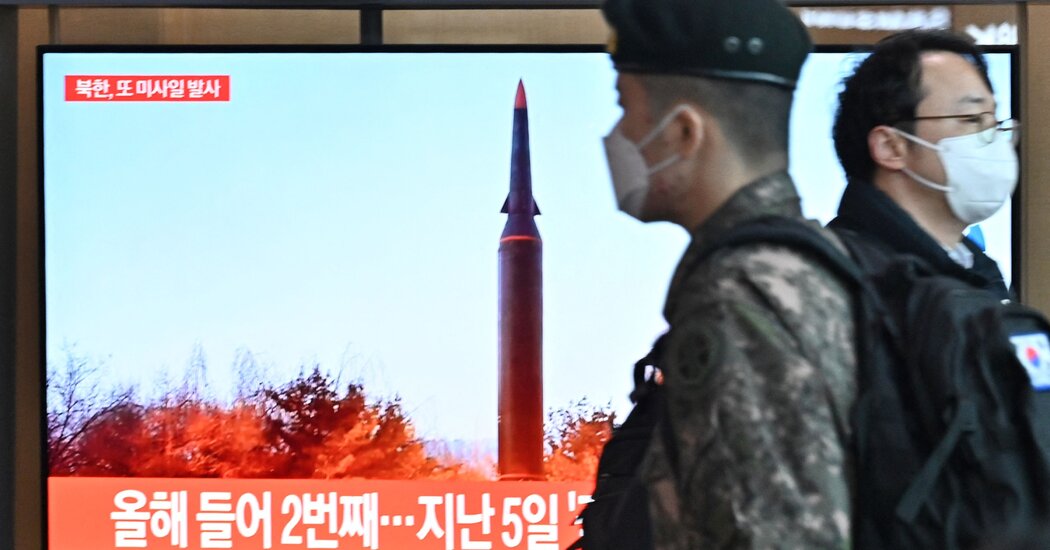
SEOUL — North Korea launched a ballistic missile off its east coast on Tuesday, its second weapons test in a week, as the United Nations Security Council met to discuss the country’s growing missile threat.
With its latest launch, North Korea appeared to demonstrate progress in developing what it calls a hypersonic missile, the South Korean military said. The missile flew about 435 miles, traveling at up to Mach 10, or 10 times the speed of sound, it said.
It was not only the new missile’s speed that highlighted North Korea’s growing missile threat to the United States’ military and its allies in the region. The new missiles North Korea has tested in the past week also had a so-called maneuverable re-entry vehicle, or a warhead that can thwart missile defense systems by changing course in the atmosphere after it is detached from the booster rocket, South Korean defense officials said.
When North Korea conducted its last test of a hypersonic missile off its east coast on Wednesday, South Korea refused to call it hypersonic, noting that it had flown at Mach 6. As if to rebut the South, the missile North Korea launched on Tuesday flew much faster.
“Our military has the ability to detect and shoot down the projectile North Korea launched today, and we are continuing to strengthen our response system,” the South Korean military said in a statement on Tuesday.
Still, the North’s latest test, it said, amounted to a “grave threat to international peace and stability.” The United States military in South Korea said that although the test “does not pose an immediate threat” to the United States or South Korea, it “highlights the destabilizing impact” of the North’s illicit weapons program.
Evidence of North Korea’s hypersonic missile program first emerged publicly in January last year, when the country disclosed an array of new weapons it said it was developing, including multiple-warhead nuclear missiles and a nuclear-powered submarine. Then, the North conducted its first test of what it called a hypersonic missile, the Hwasong-8, in September. In an exhibition of military gear the following month, it also displayed what looked like a hypersonic missile with a detachable gliding warhead.
The recent tests are all in violation of multiple U.N. Security Council resolutions that ban North Korea from developing or testing ballistic missiles or nuclear devices.
North Korea’s actions on Tuesday occurred as the Security Council met at the U.N. headquarters in New York to discuss the country’s last ballistic missile test, which envoys from the United States, Japan, France, Britain and two other countries called “a threat to international peace and security.”
“Each missile launch serves not only to advance the D.P.R.K.’s own capabilities, but to expand the suite of weapons available for export to its illicit arms clients and dealers around the world,” the envoys said in a joint statement, using the acronym for the North’s official name, the Democratic People’s Republic of Korea. “The D.P.R.K. makes these military investments at the expense of the well-being of the North Korean people.”
The envoys urged the council to ”stand united in opposing the D.P.R.K.’s ongoing, destabilizing and unlawful actions,” and called on all U.N. member states to “fulfill their sanctions obligations under the Security Council resolutions.”
Prime Minister Fumio Kishida of Japan told reporters on Tuesday morning, “It is extremely regrettable that North Korea launched a missile in this situation.”
North Korea has not tested any long-range missiles of the kind that could directly threaten the continental United States since it conducted three intercontinental ballistic missile tests in 2017. But since attempts at diplomacy by its leader, Kim Jong-un, with President Donald J. Trump collapsed in 2019, the country has resumed testing mostly short-range missiles, including ones launched from trains rolled out of tunnels.
Those tests indicated that the North was developing more sophisticated ways of delivering nuclear and other warheads to South Korea, Japan and American bases, according to defense analysts. Some of the missiles it has tested since 2019 have used solid fuel and have made midair maneuvers, making them harder to intercept, defense analysts said.
After the I.C.B.M. tests in 2017, Mr. Kim claimed that his country had the ability to launch a nuclear strike against the continental United States. Then he met Mr. Trump three times between 2018 and 2019 to push the United States to ease sanctions imposed under Security Council resolutions.
The Kim-Trump diplomacy collapsed without an agreement on rolling back the North’s nuclear weapons program or lifting international sanctions.
During a five-day Workers’ Party meeting that ended on Dec. 31 in Pyongyang, the North Korean capital, Mr. Kim said conditions in his country demanded “bolstering the state defense capability” without “a moment’s delay.”
But he also said his country should focus on alleviating chronic food shortages — a problem that he inherited from Kim Jong-il, his father and predecessor, who died 10 years ago, and which the North has yet to fix.
North Korea remains extremely wary of any contact with the outside world during the coronavirus pandemic, and has claimed no cases of the virus in the country, which outside experts have questioned.
Rick Gladstone contributed reporting from New York, and Motoko Rich from Tokyo.


More Stories
Elapath Energy’s Ambitious Gas Storage Construction Paves the Way for Renewable Energy Revolution in Singapore
Save Earth Mission: Uniting the World in the Biggest Movement for a Sustainable Future
Lieutenant General Vijay Kumar Singh, the Revered Patriot, to Grace the Spectacular Grand Takeoff Event of Save Earth Mission